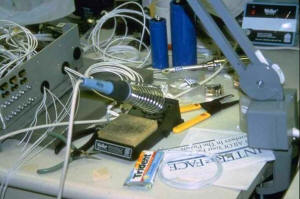 |
| Using the work surface for storage leads to clutter, wasted time and motions |
Principles affected
Related pages
Tools
Workstations
Background
“Storage” refers here to placement of tools and materials in the immediate work area (not a warehouse or storeroom).
Inattention to proper storage of tools and materials at the workstation can lead to congestion and inefficiency. When there is no particular place for an item, employees waste time searching, often using motions that add to the wear and tear on shoulders and hands. A particular problem is using the work surface itself for storage, which tends to waste space as well as time and motions.
Objectives
Keep materials close to minimize reaching and keep them organized to reduce wasted time and motions.
Ideas and Options
5S
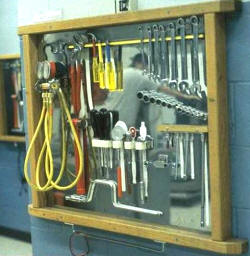 |
| Good organization makes access fast and easy |
5S basically means “a place for everything and everything in its place (and make sure it’s in the right place).” The S’s originated with Japanese words that have been rendered into English as Sorting, Straightening, Shining, Standardizing, and Sustaining. Some companies add a 6th “s” for Safety and call this process “6S.”
It can be surprising how much congestion can be reduced with a good 5S process, as well as time and motions saved because of being able to find tools and materials quickly. There are many approaches to good organization, including the Strategies for arranging work areas (see layouts).
Shelf height
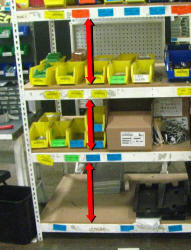 |
|
| Shelves too far apart | Green, yellow, and red zones for storage |
It is all too common for storage shelves to be placed too far apart vertically. Moving the shelves closer together can allow more usable storage space while minimizing the need to bend to the low shelves or reach up to high ones. The most valuable shelves are the ones at about elbow or waist height, which should be reserved for items that are either heavy or frequently used. This height is called the “green” zone in ergonomics and the “golden” zone in the world of distribution centers (see height).
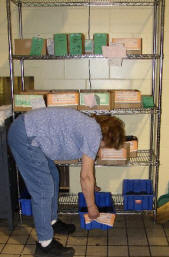 |
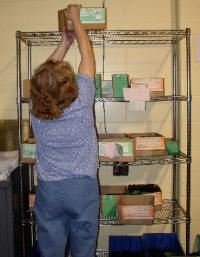 |
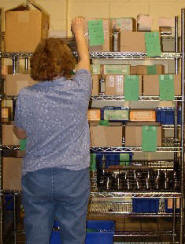 |
| Before: too low | Before: too high | After: better (but not perfect) |
This example shows shelves set too far apart, causing high reaches and low bends. The shelves were quickly adjusted to lower the high shelves and raise the bottom ones. A tip for conducting task evaluations is to look for unused space between shelves, which indicates the shelves can be moved closer together.
Many shelving units are easily adjustable (e.g. www.metro.com) and can be changed within a few minutes. The rule of thumb is to set the vertical distance between shelves just far enough apart to provide clearance to access the materials.
Vertical vs. horizontal storage
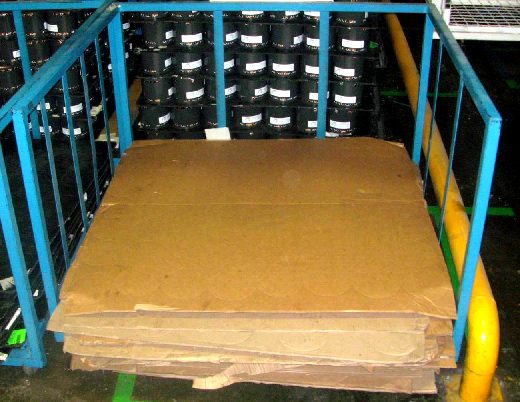 |
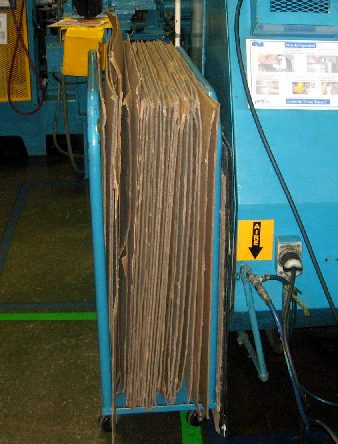 |
| Horizontal storage | Vertical storage |
A very simple technique for long thin objects is to store them vertically rather than horizontally. The horizontal orientation requires bending for the lowest layers and reaching overhead for the highest ones. Simply changing the orientation to vertical keeps every single item at a good height. Depending upon the number of items, vertical storage can also reduce the footprint.
Casters
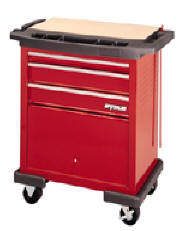 |
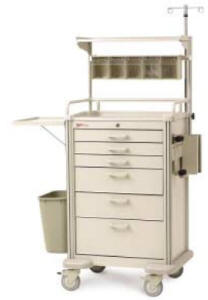 |
| Mobile tool cart (www.waterlooindustries.com | Mobile tool cart doubling as workstation (www.metro.com) |
Putting drawers or any other type of storage unit on casters can optimize floor space, convenience, and flexibility. See also carts and wheels.
Racks
 |
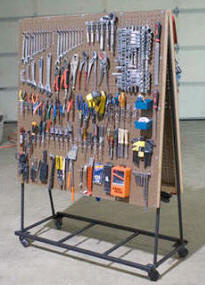 |
| Two examples of mobile tool racks — visible and easy access | |
Racks of different types are common ways to provide storage that is convenient because of (a) the ability to quickly see where an item is (compared to digging through drawers) and (b) quick physical access (compared to taking the extra steps of opening and closing drawers). Both of the above racks are on casters.
Articulating arms
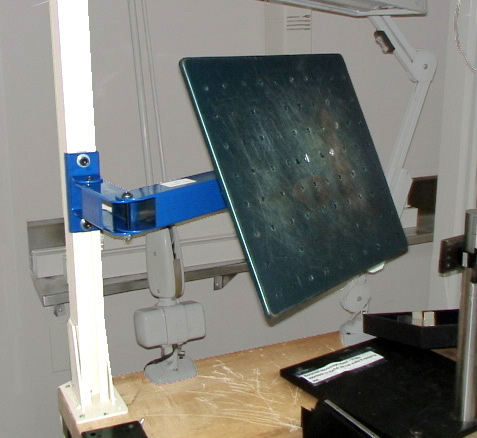 |
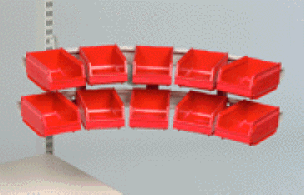 |
| Pegboard rack on arm | Parts trays on arm |
Articulating arms enable tools and materials to be moved close in or pushed out of the way, depending on needs. The arms themselves enable materials to be stored above a work surface, keeping the work area free of clutter and taking advantage of vertical space. See www.ergosource.com.
Small carousels
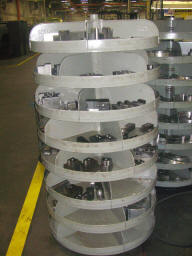 |
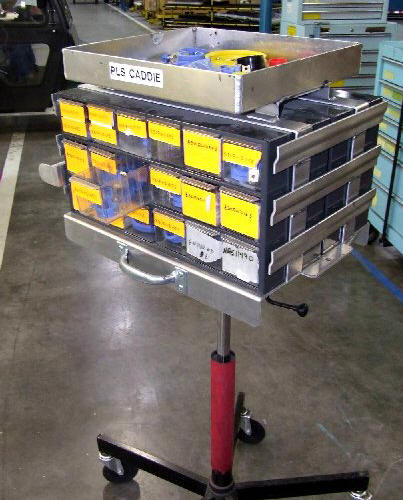 |
| Standard circular carousel | Parts carousel on pedestal and casters |
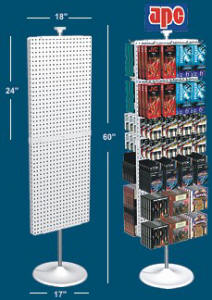 |
 |
| Retail store carousels | Bench carousel/tool caddy |
Carousels of all types can provide effective use of space. Don’t neglect to consider the types of carousels used in retail stores (e.g. for sunglasses and post cards), which provide inexpensive, floor-based storage systems.
Powered carousels
(vertical and horizontal)
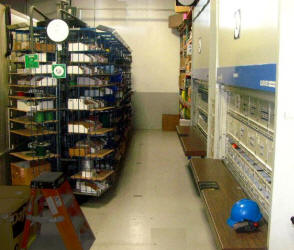 |
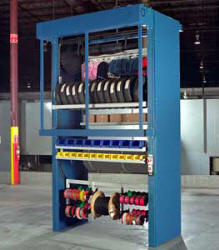 |
| Horizontal carousel (left) and enclosed vertical carousel for small parts (right) | Open vertical carousel for both small and large parts (www.jdstorage.com) |
Powered carousels have long been used in retail stores, such as for rolls of carpets or for spools of wire in hardware stores, and are now becoming common in manufacturing plants. Vertical carousels are especially helpful because (a) they provide efficient use of vertical space, and (b) they enable lifting at waist height, with no need to bend down or reach overhead.
Lateral sliding bins
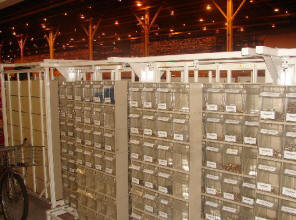 |
| Lateral sliding bins |
An uncommon, but effective type of storage for small items are bins that slide laterally. The lateral slides allow for storage of large numbers of parts within easy access. These systems lend themselves to establishing separate racks for different products, thus minimizing changeover time.
Heavy duty shelf slides
 |
 |
| Slide out shelves | Integrated rollers |
Slides and rollers can be added to shelf units to lighten loads and provide easier access.
Storage pedestals
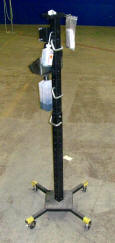 |
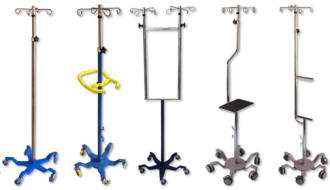 |
| Homemade pedestal holder | Hospital IV poles |
Pedestals on casters provide yet another approach to holding tools and materials providing both flexibility and a small footprint. Hospital IV poles provide an off-the-shelf solution for handling wires, cables, and other long stringy items. Some variants also provide hooks and flat surfaces.
Holsters
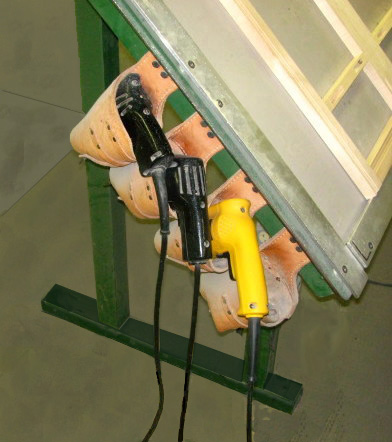 |
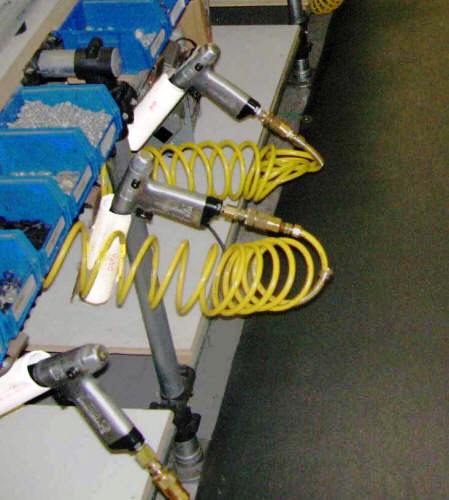 |
| Leather | PVC |
Several styles of holsters. Proximity to the point of use is based on frequency of use. Tools used constantly should ideally have holsters (or equivalent) within reach envelope of the forearm.
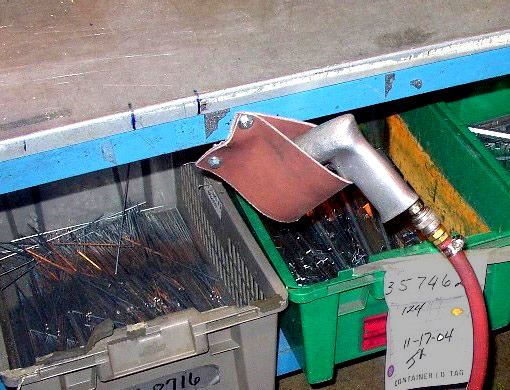 |
 |
| Strap | Wood |
By and large, holsters are inexpensive. Multiple options are available, usually homemade.
Aprons and belts
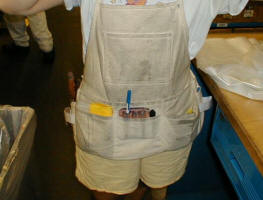 |
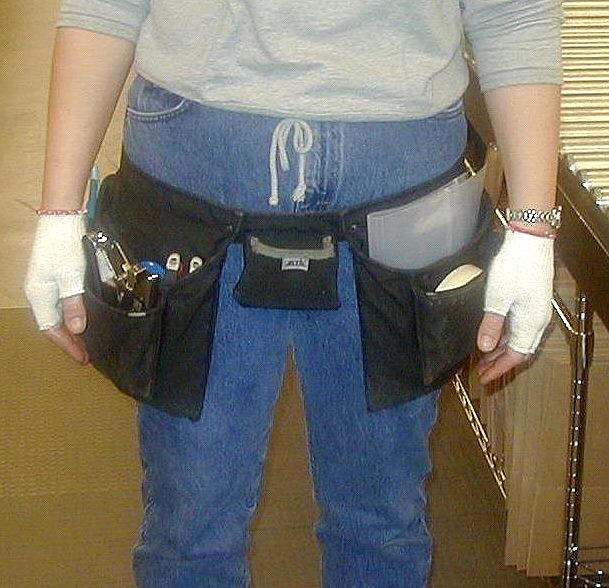 |
| Apron | Belt |
Aprons and belts provide a simple method for keeping items immediately at hand. They are widely used throughout both construction and manufacturing, but oddly, in some operations. never considered.
Magnetic holders
 |
 |
| Magnetic dish and bars | Magnetic holder for material cups |
Magnets provide a quick and convenient way to hold steel items. Magnetic dishes (above left) make small items easy to see and handle. Magnetic holders can be used to support multiple other types of containers. (Vacuum cups can be used in the same way for non-steel items.)
Misc. tool storage
Countless additional techniques provide ways to store tools at the point of use, as shown in these photos:
 |
 |
| Low cost Styrofoam holder | Vertical tool box |
 |
 |
| Counterbalances provide point-of-use storage | Small bench top drawer unit |
Components for custom racks
 |
|
| Creform® rack |
A number of vendors provide components to easily create custom shelves, racks, and carts.
www.creform.com
www.8020.net
www.metro.com
www.unistrut.com
www.ez-build.net/
www.edsal.com
www.globalindustrial.com
Comment: House trailers and RVs
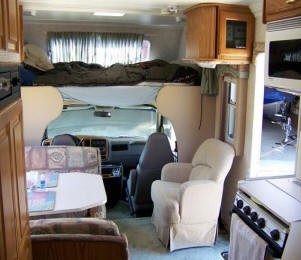 |
| Compact and highly organized recreational vehicle |
For inspiration on how to accommodate a large amount of storage in a very small space, check out house trailers and RVs. In well-designed units, every nook and cranny provides functional storage space.
